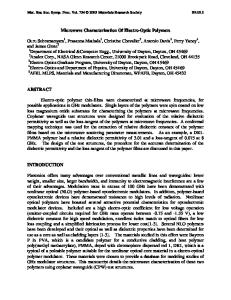Microwave Processing of Polymers and Polymeric Composites
- PDF / 124,635 Bytes
- 2 Pages / 420.48 x 639 pts Page_size
- 101 Downloads / 471 Views
MICROWAVE PROCESSING OF POLYMERS AND POLYMERIC COMPOSITES
DR. CHARLES Y-C LEE Air Force Materials Laboratory, WRDCIMLBP, Wright-Patterson Air Force Base, OH 45433-6533
Microwave energy is commonly considered as a fast and efficient source of energy for heating materials. This perception can be easily verified by the proliferation of microwave ovens in household kitchens and the emerging usage of the technology in the food industry. From the standpoint of material science, coupling of microwave energy into materials during processing can be more than just shortening the heat-up time in conventional thermal treatment; this energy source can provide an additional degree of control over the properties developed during processing. Under a multidisciplinary research program sponsored by Defense Advanced Research Projects Agency (DARPA) and managed by the US Air Force and Army, many fundamental issues of applying this technology to polymer and composite processing were addressed. The following seven papers are based on work supported by this program. Researchers at Michigan State University (J. Asmussen and M. Hawley) designed an applicator with closed loop control so that the coupling of microwave energy into polymeric and composite materials could be studied in a controlled manner. The cavity enabled the setting of a well defined resonance mode prior to sample loading and the close loop control was used to change the power input level to accommodate material properties changes during processing by maintaining a well controlled heating profile. Researchers at Virginia Polytechnic Institute (J. McGrath and T. Ward) have used this applicator and discovered many interesting phenomena in microwave processing of polymeric materials. Among the findings was the selectivity of chemistry in microwave coupling where one type of chemistry (imidization) was favored over another type (acetylenic reaction), thus potentially providing a new dimension of control over polymer synthesis and processing. The apparent activation energy of the kinetics appeared to be affected also, indicating that the effect was more than just a more efficient transfer of energy into the material bulk. In processing a two-component system, the phase separation morphology of the resultant samples can be controlled by the microwave energy coupling conditions. Other researchers at VPI (G. Wilkes et al) extended this technology to other materials including ceramers and found that the properties development can be accomplished in minutes instead of days. While heating of dielectric materials and polymeric/glass fiber composites can be accomplished readily, application of microwave energy to carbon fiber composites has always been hampered by the conductive nature of the carbon fibers. Research conducted in the Materials Laboratory showed that the heating profile of composite laminates could be influenced by the mode setting of the cavity, location of the sample in the cavity, orientation of the sample relative to the power probe and stacking sequence of the lami
Data Loading...









